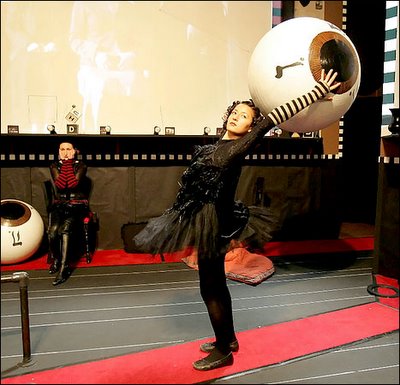Zomboid! (Film/Performance Project #1) written and directed by Richard Foreman

by Charlotte Deaver
At this time last year, Richard Foreman announced that he would no longer produce plays, but was shifting his medium to film. It was pretty shocking news, considering that he has been presenting theater annually in New York City since 1968. Due to the exuberant influence of my husband I've been attending his plays since Film is Evil: Radio is Good in 1987.
With NYC boasting The Wooster Group, Robert Wilson, Meredith Monk, and John Jesurun, among many others, avant garde theater is well represented here. But were we to think, with the crushing news of Foreman's abandonment of the stage last year, that we might be losing one of our most loyal participants?
As it turns out, the answer is both yes and no.
Zomboid!, Foreman's current work, is indeed partly film. Playing in the Theater at St. Mark's, for years the home of the Ontological-Hysteric Theater, it is also in many ways like Foreman's other plays: spatial orientation is distorted by glass partitions that reflect the audience, wires strung throughout both theater and stage, and light-bulbs that snap randomly and jarringly; music and spoken-word loops recall echoes of old radio shows and Cagean experimentalism; the set, too, remains crowded, intense, and laden with hand-made props such as large eyeballs, candles, chalkboards, stuffed animals, and oil paintings.
The incorporation of film (two large screens set at right angles), however, changes the effect of the set dramatically. By opening it up, expanding it out into the world, the sense of mystery and dread is all but eliminated. At the expense of the usually claustrophobic, densely psychological atmosphere evoked by the set, the Australian sun pours through windows in the films, which portray severe-looking, Euro-chic actors who dress like antiseptic architects from Brussels, move very little, and occasionally repeat hypothetical propositions (none of which I can recall, or I would recite them here).
Previously, actors would wander the stage in a Foreman play, bewildered and lost, teased and tempted, offering abstruse yet provocative verbal gems. In this performance, several actresses stalk the stage, sometimes as sex kitten/victims, sometimes as dominatrix/aggressors, as one lumbering, leather-bound actor, tall and dark, fields their affection or abuse. While this is a typical dynamic for Foreman’s characters, the tension between them seems lost in this new, austere, diffused language of film and live theater.
As with all of Foreman's work, there (absolutely and defiantly) is no plot. If the plays have been, in fact, *about* something, it is of elemental philosophical questions of being, desire, impulse, the relationship between the mind and reality, and language. The script, untethered by narrative, is as abstract as consciousness itself. In Zomboid!, however, the verbal text is even more minimal than usual. As if to explain, the cover of the program reads:
"Mostly -- people are interested in 'events'. But I find more potent, the time between events, the oscillation of the field -- in this case that potent "staging area" in front of filmed tableaux, in which the archetypically 'blindfolded' hover like semi-visible Gods -- semi-controlling the wobble of 'blind' impulsive behavior on the stage below."
Unfortunately, the "events" in Zomboid! between which we "wobble" are too flat, are not quizzical enough, making that desired "oscillation" vibrate only a little. As an idea, it is compelling, and in Foreman's theater, usually equally so. With this newer "performance," though, staging and film don't quite live up to the concept.








